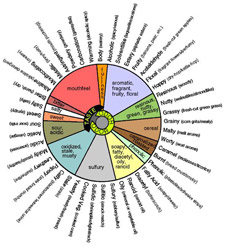 Class will be in session next week when Mike Steinberger launches a three-part series on sensory perception and wine at Slate, the online magazine.
Class will be in session next week when Mike Steinberger launches a three-part series on sensory perception and wine at Slate, the online magazine.
Steinberger warms up with a discussion of why wine writers use the descriptions they do.
What does this have to do with beer? The wine flavor wheel and the beer flavor wheel (click on the image to enlarge) are different, but the fact is that flavors are flavors and aromas are aromas.
The parallels are not perfect. Steinberger talks about the evolution of how the wine writers describe wines, but I’ve never see a similar history of beer tasting notes. But when he documents that there are scientific explanations – that is, fermentation byproducts that can be measured – for flavors and aromas he could just as well be talking about beer.
That’s why I’m looking forward to the series.
Reading his story sent me rifling through notes taken while reading Emperor of Scent.
The book relates mostly to the perfume industry, though there’s plenty about the disagreement (and politics) within the academic community about how we smell. You realize that Luca Turin, the protagonist, doesn’t perceive aromas like you and I. Just as different people perceive beer differently.
Early on Turin says, “You know perhaps the edge I have in turning smell into language is that for me smell has always had an utterly solid reality that, to my utter astonishment, it doesn’t seem to have for other people. Every perfume I’ve ever smelled has been like a movie, sound and vision …”
He also says, “France is a country that understands that, much as in music an orchestra is not just violins, the range of smells that makes life interesting includes some rather severe ones.
“Your taste and smell is part biology and part culture…. When they smell (rotten cheese) Americans think, ‘Good God!‘ The Japanese think, ‘I must now commit suicide.’ The French think, ‘Where’s the bread?'”
As the parent of a 10-year-old American who has developed an affection for stinky (and not cheap) cheese I can tell you that is changing.
Updated June 21: Steinberger so far has examined the age-old stoner’s question: Do you taste what I taste? Then whether or not he’s a “supertaster.” And tomorrow, he’ll explore whether being a supertaster helps you evaluate wine. Some good stuff (good read it), but I’m waiting for all three parts comment. Since I’m off to the National Homebrewers Conference in Denver it will be the beginning of next week before I can.
It’s interesting to me that the majority of the “wheel” is comprised of what most people would view as negative smells/tastes. Not that the negatives shouldn’t be there, but that the positives should be highlighted more. I would think that something like “fruity” would be broken down a little more into different kinds of fruit.
Jonathan – Morten Meilgaard introduced the Flavor Wheel in the 1970s. It was developed to identify (and thus avoiding) off flavors – so that’s why can be only a starting place when discussing beer flavors.
We’ve learned a lot about sensory perception since then.
Additionally, think of the hop varieties that have been developed since the ’70s, and the need to talk about the citrus and piney flavors (as well as peach, mango, etc.) they add.
Oooh! Thanks for the PDF. It’s definitely more clear when teed up as a framework for identifying off-flavors.